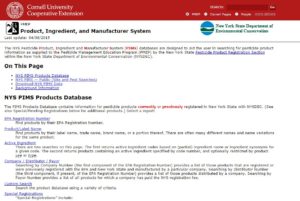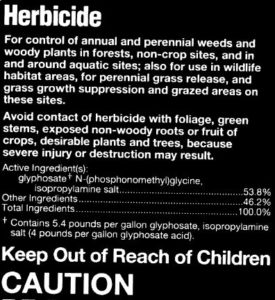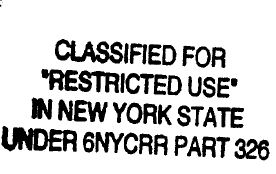Understanding the Pesticide Label
Pesticides refer to a chemical, regulated by the US Environmental Protection Agency, that will prevent, destroy, or otherwise damage pests such as insects, plants, fungi, rodents, etc. Used correctly and judiciously, pesticides are an effective and safe tool. Specific types of pesticides include, for example, herbicides that control plants, insecticides that control insects, or fungicides that control fungi. Depending on the chemicals in the pesticide, the product might be selective to specific types of pests, such as grasses vs. broad leaf plants. The product might also be general or broad-spectrum and control most species of its category. Woodlot owners can learn more about pesticides through tutorials available on the Cornell Cooperative Extension website.

The Product, Ingredient, and Manufacturer System (PIMS) is a website that includes the label for every pesticide registered for use in NY. The labels include essential information. PIMS allows users to learn about a specific product before purchasing.
Every pesticide has a “label”, which is a written or graphic instruction attached to the container. “The label is the law,” and the label has essential information for the user of the pesticide. For example, the label will indicate the types of pests – often the individual species – for which the product is intended to control. Federal law requires that the manufacturer test each active ingredient and submit the findings to the EPA who assesses whether the product is safe for use. The conditions of use are then part of the label. The process of labeling a pesticide so that it is registered for use can take 8 to 10 years and cost $35 to $50 million.
The US EPA initially registers a pesticide when they approve a label. A state will subsequently register a pesticide before it can be sold, distributed or used in that state. The conditions of use in a state may be more restrictive than the conditions of use stipulated by the EPA. The label of every pesticide registered for use in New York can be viewed at http://pims.psur.cornell.edu/ (Figure 1).
This site, known as the PIMS website, helps users evaluate different pesticides, obtain free copies of the label, and understand if a pesticide is appropriate for their needs before the pesticide is purchased or used. New York woodlot owners should refer to labels on the PIMS site, not those obtain by a general search of the Internet or a manufacturer’s website.
Most labels, and those described below, are considered primary labels. However, a special type of label is the 2(ee) label for “emergency exemption.” These labels are provided in response to special needs, often to allow the use of a specific pesticide on a new or invasive species. The PIMS website has a searchable list of 2(ee) labels.
By federal law, pesticide labels have a standardized format and information to allow users to easily find the information needed for use. Below are several of the types of information that a woodlot owner should review on a pesticide, often a herbicide, before buying or using the product.
- Pesticides are classified as “restricted” or “general use”. “Restricted use” products can only be used by a private or commercial certified applicator, whereas general use products can be used by
Although the US EPA may classify a pesticide as “general use” and available to everyone, NYS DEC can be more restrictive and re-classify a pesticide as “restricted use.” Restricted use pesticides can only be used by a certified applicator. For example, Garlon 4 is general use in Pennsylvania, but is restricted use in New York.
anyone. NYSDEC designates some products as restricted if they deem there are special needs related to the safe application of the product. (Figure 2). This classification will only be visible on labels sold or distributed in NY. Therefore, a product such as Garlon 4 might be “General Use” in Pennsylvania, but is “Restricted Use” in New York. By viewing labels on the PIMS website, users can determine the classification of a product.
- The label will indicate the type of pesticide (e.g., herbicide, fungicide, etc.) and the brand name or trademark label. This information is used to communicate with others the product that is being used, and can be searched for via the PIMS website
- All pesticides have a product registration number issued by the EPA. This is a unique number, similar to the Latin name of a plant, used to identify the product. The product registration number can be searched for on the PIMS website.
- The label lists the active ingredients and their percentage in the product. (Figure 3). The concentration of the active ingredient is important to know because it determines if the product is ready to use from the container or if it needs to be diluted. Glyphosate, an example of a common active ingredient in some herbicides, might be 2% in one product and suitable for use as a foliar spray, or might be 50% in a different product and diluted 1 to 1 in water for use in cut-stump treatments.
- The label will list a signal word to indicate the relative toxicity. The signal words are “Danger/Poison”, “Warning”, or “Caution.”
- Precautionary statements will indicate actions the applicator should take to protect themselves, fish and wildlife, or the environment. The relative toxicity will correspond to the types of personal protective equipment (PPE) necessary to protect the applicator. The label will list the minimum required PPE, but applicators can always wear extra PPE. For example, it is always a good practice to wear eye protection and protective gloves even if not required by the label. The statement will indicate whether the product has toxicity by way of inhalation, ingestion, or to the eyes or skin.
- A first aid statement indicates how to treat a person exposed to the pesticide.
- Agricultural use requirements indicate actions necessary to protect agricultural workers. Agricultural workers, those paid to work on the property, are considered at greater risk than the general public because of the potential for frequent exposure. The protections are delineated on the label and include the “Restricted Entry Interval” (REI) which is the number of hours before an agricultural worker can enter the site without specific protective clothing. The label specifies the protective clothing required for entry during the REI.
- At some place on the label, there will be statements that should be common sense to applicators. These include statement such as: avoid contamination of food or feed, wash contaminated clothing before reuse, wash hands before eating or smoking, etc. These generally recognize the need to reduce exposure, and especially to protect vulnerable individuals, such as children, from exposure.
- The final section, often several pages long, includes directions for use of the product. This information will specify the appropriate target species; in NY a pesticide is considered appropriate only if the target species is listed by name on the label, or the label describes target species and uses a general term such as “and other woody species.” The directions for use will indicate the mode of treatment, for example foliar spray, cut stump, basal bark, or injection. This section will also provide dilution formulas to allow mixing of the product to achieve a specific concentration. If a pesticide can be mixed with other pesticides or fertilizers, those will be listed. Finally, the dose that is permissible will be listed as a quantity per acre that should not be exceeded. In agricultural applications, which include woodlots, the applicator can legally apply less than the specified dose rate to reduce the costs and reduce the amount of the pesticide released into the environment.

The label lists the active ingredients and their concentration. The concentration is important to know because some forumations can be used directly from the container, but other formulations need to be diluted. The label will give guidance on how to make dilutions. Pesticide labels will indicate the relative toxicity, known as the “signal word”, which include Danger, Warning, and Caution.
The label on a pesticide is carefully prepared. It contains information that will aid the applicator in a safe and effective application. The label is considered a legal document, and failure to follow the label may put the applicator in jeopardy. Before purchasing, and certainly before applying a pesticide, the user should read and understand all parts of the label. Personally, I use a limited number of pesticides, yet I read the label every time I make an application.
Some people will suggest you use an unlabeled product to control pests. This is illegal in New York and many other states. The conversation will often go something like…”my cousin told me that if you take yesterday’s coffee, mix in the ears of your neighbor’s cat, add a tablespoon of spicy mustard, a quart of diesel fuel, and let this steep in your closet until the next full moon, it will ‘work on’ such and such a plant.” People often encourage these home remedies to (1) avoid costs or (2) avoid putting chemicals into the environment. Because home remedies are not tested their efficacy is unknown and direct or opportunity costs can escalate. Also, the home remedy is a mixture of chemical, but unlike a registered pesticide the chemical and their action in the environment is unknown.
Woodlot owners and foresters should be informed about all aspects of pesticides if they intend to use these products. Specific strategies for the safe use of herbicides are presented in one or more webinars available at www.youtube.com/ForestConnect. Also, a handbook about forest vegetation control and multiple methods is provided at www.extension.psu.edu/fvm Information used in this article was obtained from the Cornell Cooperative Extension Pesticide Management Education Program.


